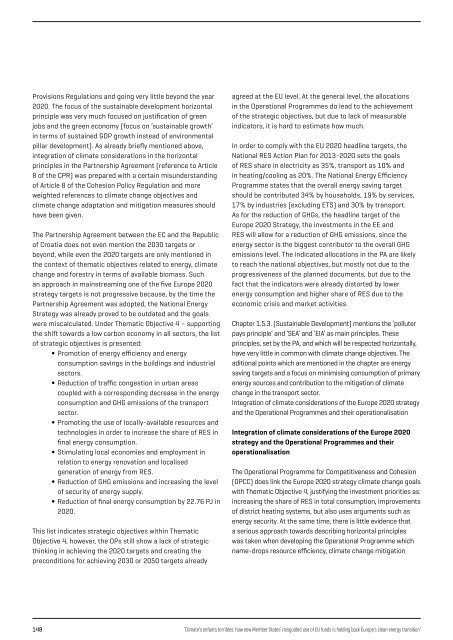ENFANTS TERRIBLES
enfants-terribles
enfants-terribles
Create successful ePaper yourself
Turn your PDF publications into a flip-book with our unique Google optimized e-Paper software.
Provisions Regulations and going very little beyond the year<br />
2020. The focus of the sustainable development horizontal<br />
principle was very much focused on justification of green<br />
jobs and the green economy (focus on ’sustainable growth’<br />
in terms of sustained GDP growth instead of environmental<br />
pillar development). As already briefly mentioned above,<br />
integration of climate considerations in the horizontal<br />
principles in the Partnership Agreement (reference to Article<br />
8 of the CPR) was prepared with a certain misunderstanding<br />
of Article 8 of the Cohesion Policy Regulation and more<br />
weighted references to climate change objectives and<br />
climate change adaptation and mitigation measures should<br />
have been given.<br />
The Partnership Agreement between the EC and the Republic<br />
of Croatia does not even mention the 2030 targets or<br />
beyond, while even the 2020 targets are only mentioned in<br />
the context of thematic objectives related to energy, climate<br />
change and forestry in terms of available biomass. Such<br />
an approach in mainstreaming one of the five Europe 2020<br />
strategy targets is not progressive because, by the time the<br />
Partnership Agreement was adopted, the National Energy<br />
Strategy was already proved to be outdated and the goals<br />
were miscalculated. Under Thematic Objective 4 – supporting<br />
the shift towards a low carbon economy in all sectors, the list<br />
of strategic objectives is presented:<br />
• Promotion of energy efficiency and energy<br />
consumption savings in the buildings and industrial<br />
sectors.<br />
• Reduction of traffic congestion in urban areas<br />
coupled with a corresponding decrease in the energy<br />
consumption and GHG emissions of the transport<br />
sector.<br />
• Promoting the use of locally-available resources and<br />
technologies in order to increase the share of RES in<br />
final energy consumption.<br />
• Stimulating local economies and employment in<br />
relation to energy renovation and localised<br />
generation of energy from RES.<br />
• Reduction of GHG emissions and increasing the level<br />
of security of energy supply.<br />
• Reduction of final energy consumption by 22.76 PJ in<br />
2020.<br />
This list indicates strategic objectives within Thematic<br />
Objective 4, however, the OPs still show a lack of strategic<br />
thinking in achieving the 2020 targets and creating the<br />
preconditions for achieving 2030 or 2050 targets already<br />
agreed at the EU level. At the general level, the allocations<br />
in the Operational Programmes do lead to the achievement<br />
of the strategic objectives, but due to lack of measurable<br />
indicators, it is hard to estimate how much.<br />
In order to comply with the EU 2020 headline targets, the<br />
National RES Action Plan for 2013-2020 sets the goals<br />
of RES share in electricity as 35%, transport as 10% and<br />
in heating/cooling as 20%. The National Energy Efficiency<br />
Programme states that the overall energy saving target<br />
should be contributed 34% by households, 19% by services,<br />
17% by industries (excluding ETS) and 30% by transport.<br />
As for the reduction of GHGs, the headline target of the<br />
Europe 2020 Strategy, the investments in the EE and<br />
RES will allow for a reduction of GHG emissions, since the<br />
energy sector is the biggest contributor to the overall GHG<br />
emissions level. The indicated allocations in the PA are likely<br />
to reach the national objectives, but mostly not due to the<br />
progressiveness of the planned documents, but due to the<br />
fact that the indicators were already distorted by lower<br />
energy consumption and higher share of RES due to the<br />
economic crisis and market activities.<br />
Chapter 1.5.3. (Sustainable Development) mentions the ’polluter<br />
pays principle’ and ’SEA’ and ’EIA’ as main principles. These<br />
principles, set by the PA, and which will be respected horizontally,<br />
have very little in common with climate change objectives. The<br />
aditional points which are mentioned in the chapter are energy<br />
saving targets and a focus on minimising consumption of primary<br />
energy sources and contribution to the mitigation of climate<br />
change in the transport sector.<br />
Integration of climate considerations of the Europe 2020 strategy<br />
and the Operational Programmes and their operationalisation<br />
Integration of climate considerations of the Europe 2020<br />
strategy and the Operational Programmes and their<br />
operationalisation<br />
The Operational Programme for Competitiveness and Cohesion<br />
(OPCC) does link the Europe 2020 strategy climate change goals<br />
with Thematic Objective 4, justifying the investment priorities as:<br />
increasing the share of RES in total consumption, improvements<br />
of district heating systems, but also uses arguments such as<br />
energy security. At the same time, there is little evidence that<br />
a serious approach towards describing horizontal principles<br />
was taken when developing the Operational Programme which<br />
name-drops resource efficiency, climate change mitigation<br />
148<br />
‘Climate’s enfants terribles: how new Member States’ misguided use of EU funds is holding back Europe’s clean energy transition’


